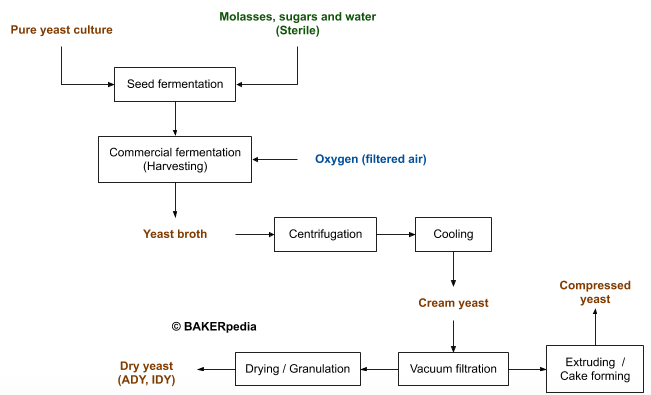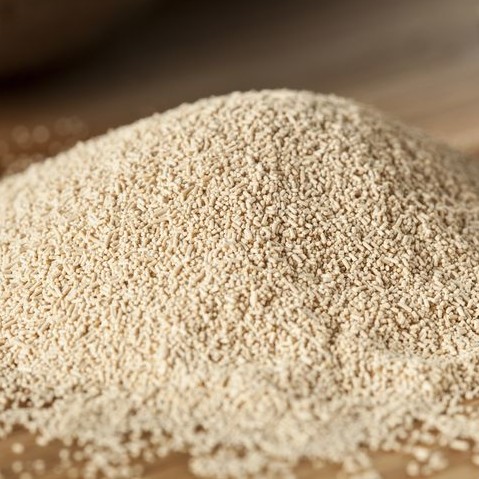Yeast
Also known as bakers’ yeast or Saccharomyces cerevisiae
What is Yeast?
Yeast is a single-celled living organism widely used in baking, brewing, winemaking and other industries.
Saccharomyces cerevisiae can ferment and metabolize a variety of sugars under anaerobic conditions with preference for glucose, fructose and maltose. As a result, it produces carbon dioxide, ethanol and other organic compounds.1,2 In baking, the most common forms used are:
- Compressed
- Cream
- Active or Inactive Dry
Origin
Various classes of yeasts can be found in many ecosystems and food processing environments. They can be isolated from the nectar of flowers, skins of fruits, honey, surfaces of leaves and plants. In addition, they occur in the soil or can be found in the air.
Function
This ingredient serves many functions in bakery products. However, the two most pronounced ones are:3,4
- Dough rising: Carbon dioxide production, which essential for dough rising to build bread volume and improve crumb grain and overall texture.
- Dough maturation and flavor development: The production of ethanol and small amounts of organic compounds, such as ketones and aldehydes. This is responsible for mellowing the dough, as well as providing flavors and aromas to bread.
Commercial production
Bakers’ yeast comes in a number of different forms, including compressed, dried/granular, cream or liquid, instant, encapsulated and frozen.

Manufacturers are developing strains that can tolerate and thrive in certain environments. Also, they can perform additional functions that are beneficial to bakers. Here are some examples:
- Calcium propionate tolerant
- Freeze-tolerant
- Osmotolerant
- High vitamin D
- Maltase negative
- Antimicrobial
- Acrylamide-reducing
- Aromatic
Application
Yeasts are chosen based on their ability to meet the bakery’s needs, the type of bread to bake, dough system, processing conditions and the equipment. Evaluating the suitability of this ingredient is based on:
- Gassing power
- Vitality
- Shelf-life
- Form (dry or liquid)
- Operational conditions at bakery
Forms used in bakeries:
| Form | Water content (%) | Solids content* (%) | Handling and application |
| Compressed | 70.0 | 30.0 |
|
| Cream | 85.0 | 15.0 |
|
| Active dry (ADY) | 5.0 | 95.0 |
|
| Instant dry (IDY) | 5.0 | 95.0 |
|
* Solids include protein, carbohydrates, cell lipids, minerals and vitamins
Yeast activity or performance is controlled by the following factors:
- pH: Yeast performs well in a pH range of 5 to 7.
- Food supply: Simple sugars in bread doughs are provided by flour, amylase activity, or added as part of formulation.
- Temperature: Yeast is most active at 104–122°F (40–50°C) and is inactivated at 140°F (60°C).
- Water content or dough hydration.
- Osmotic pressure: Salt and sugar increase osmotic pressure, which in turn slows down yeast activity.
- Time: Yeast needs sufficient time to ferment carbon sources.
FDA regulation
Baker’s yeast is a natural ingredient that can be added to food products with no limitations other than GMPs. Its dried forms are considered GRAS by the FDA.
The agency regulates that commercial yeast has the proper viable microbial content, and complies with food safety standards such as absence of pathogenic bacteria including Salmonella and E. coli, other recognized microbial pathogens or any harmful microbial toxins.5
References
- Hutkins, R.W. “Bread.” Microbiology and Technology of Fermented Foods, 2nd Edition, IFT Press and Wiley Blackwell, John Wiley & Sons, Inc, 2019, pp. 301–342.
- Poitrenaud, B. “Yeast.” Handbook of Food Science, Technology and Engineering, Volume 2, CRC Press, Taylor & Francis Group, LLC, 2006, pp. 69-1–69-18.
- Rández-Gil, F., et al. “Yeast.” Bakery Products Science and Technology, 2nd Edition, John Wiley & Sons, Ltd, 2014, pp. 153–174.
- Cauvain, S.P. “Functional Ingredients.” Technology of Breadmaking, 3rd Edition, Springer International Publishing Switzerland, 2015, pp. 84–95.
- U.S. Food and Drug Administration, CFR – Code of Federal Regulations Title 21, Part 184: Direct Food Substances Affirmed As Generally Recognized As Safe, https://www.accessdata.fda.gov/scripts/cdrh/cfdocs/cfcfr/CFRSearch.cfm?fr=101.100. Accessed 30 May 2019.


